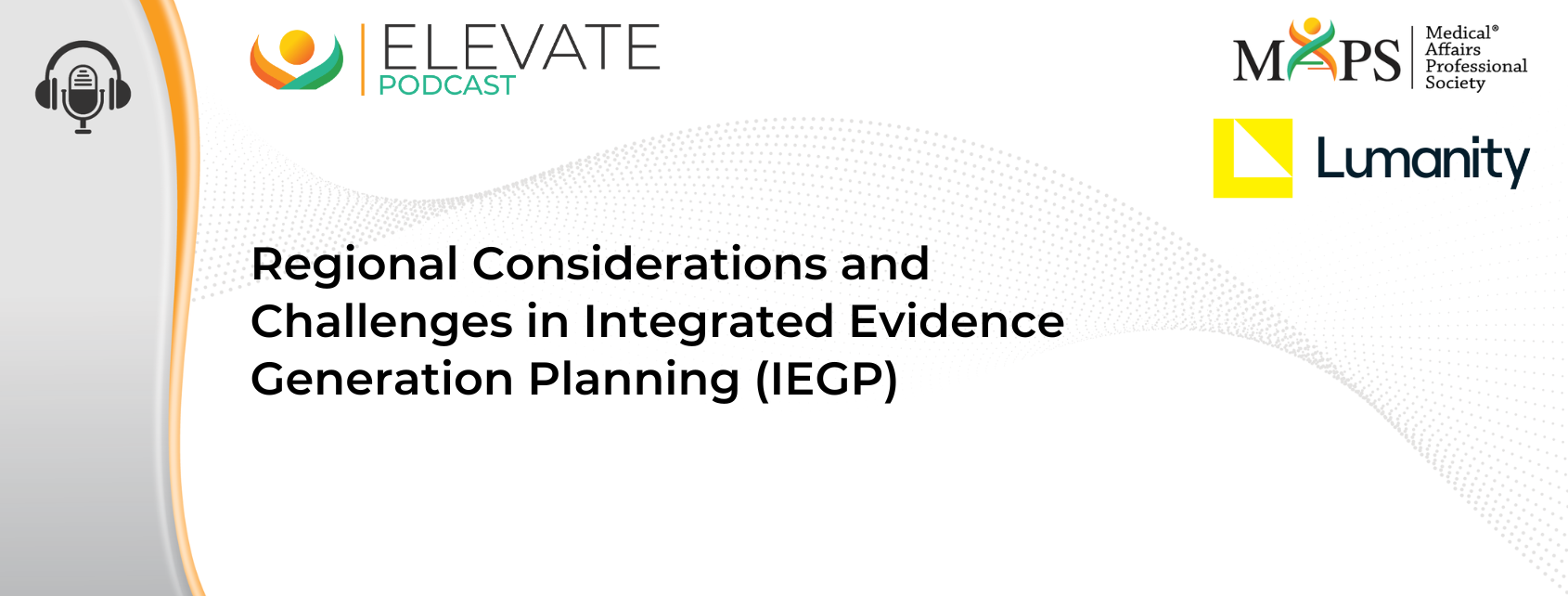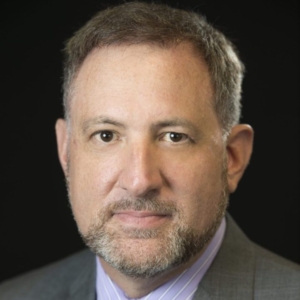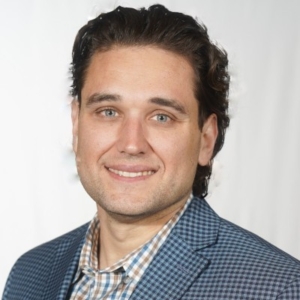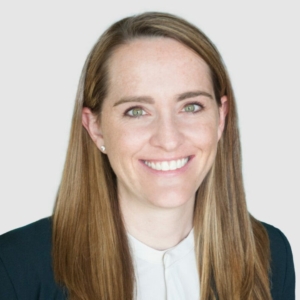Regional Considerations and Challenges in Integrated Evidence Generation Planning (IEGP)
Speaker: Meena Venkatachalam
Speaker: Steven Weisman
Speaker: Steven Serafin
Speaker: Julie Cahill
Overcoming regional disparities to ensure successful IEGP development and implementation requires effective strategies for cross-functional collaboration across diverse regions and departments. In this podcast, experts explore the many challenges associated with the operationalization of global Integrated Evidence Generation Planning (IEGP) at local levels.
Following is an automated transcription provided by otter.ai. Please excuse inaccuracies.
Garth Sundem 00:01
Garth, welcome to this episode of the Medical Affairs Professional Society podcast series, Elevate. I’m your host, Garth Sundem, and today we’re talking with experts from Lumanity about Integrated Evidence Generation Planning. Joining us are Meena Venkatachalam, Head of RWE Consulting at Lumanity, Steve Weisman, PhD, Clinical and Regulatory Lead at Lumanity, Steven Serafin, PharmD, MBA, Senior VP Market Access at Lumanity and Julie Cahill, MD, VP of Consulting and Medical Director Services at Lumanity. So we have chatted a couple times about IEGP, and I’ll encourage listeners to go back to some of our previous podcasts. We’ll link them from Medical Affairs.org. And in the most recent episode, we talked about cross functional collaboration and integration in IEGP, and today we’re going to talk about regional considerations and challenges in IEGP. So Meena RWE is such a huge piece of this. RWE from all these regions from all these places. How or sorry — what are the challenges with RWE and how can IEGP actually help overcome some of these challenges?
Meena Venkatachalam 01:35
Thank you. Big question to start with, I feel like I want to make this as simple as possible. Obviously, with RW you’re measuring what’s happening in the real world, and there can be a lot of different nuances when you think about things from different regions. I think what we often find is when we do something like an IEGP, one of the real benefits of it is that you are looking at this in a truly integrated format, so you’re having global and we often have multiple regional affiliates as part of the IEGP program, and we do workshops to sort of understand what are the key evidence gaps. And when it comes to an RWE perspective, there’s a few themes that tend to come out, and I think it’s how you want to use real world evidence from a European perspective, because you have more kind of requirements around payers and HTAs, you often find real world evidence is used to measure things like costs and healthcare resource use and measuring longer term outcomes because they’re used as part of those kind of reimbursement packages. And then with countries like the US, where you don’t have that pressure per se, real world evidence is often used more to really support clinicians and patients. So we say we use it to look at things like burden of illness and unmet need, and understanding kind of what currently is working for patients, what isn’t working, where outcomes could be improved. So there’s a lot of these regional nuances that as part of the IEGP process, you start to think through it, and there’s a lot of cross learning as well. I think that’s one of the really kind of key benefits of an IEGP, we find sometimes we see a US affiliate wanting to initiate a study, and often our kind of UK and French affiliates will jump in and go, Oh, that’s really interesting. We would like to leverage that. So there’s kind of these, how you use it, and who’s the audience, but a lot of integration and learning across the different countries involved as well.
Garth Sundem 03:21
And it’s almost because RWE is so different in these different regions and different countries that you need the IEGP to pull it all together. Is that your perspective?
Meena Venkatachalam 03:29
Yeah, exactly, exactly you need that kind of universal stepping back and thinking about a product more holistically, and then having these discussions kind of outside of your individual day to day roles, and thinking about kind of where there’s overlap, and then where there’s sort of nuances at a region level that require something more bespoke.
Garth Sundem 03:47
Okay, so specifically with the IEGP, how does the IEGP, you know, help manage these RWE challenges we talked about, you know, the fact that RWE is used differently in different places, and the IEGP is, is the plan to pull it together. But, you know, is, is that the is that the purpose of the IA GP, or does it go beyond that?
Meena Venkatachalam 04:11
I think it goes a level beyond that as well. Because I think you really get into the details of what is the evidence gap, and how do you want to fill it? And if it’s with RWE specifically, you go into the nuances of, for example, one of the big things is, if you’re going to do a study, what countries are going to be included? Because you can’t include all countries in an RWE study. If you had unlimited budget and time, you could, but that’s not, obviously never feasible. So you start thinking about, okay, what are the key countries we want to include? And that’s where we start going into things like, how similar are the clinical guidelines, how similar are treatment pattern studies, how similar are the products that are reimbursed? How similar is uptake of those products? How similar are the healthcare systems? How do patients flow through the healthcare system? And that helps you start to understand, kind of at a regional level, what’s a good prop. See, and where you can kind of what we call borrow information, and you say, Okay, we’re going to do the study in the UK, but all of those things tick across the board for France, Italy, Spain. So we can do one study, and it’s leverage for other markets versus where we need to have something that’s more at a country by country level. So there’s kind of that step further that comes through the ihgp process, really thinking about what countries are going to be included and why and how, how and when you can borrow information. And then more operational aspects as well, which is, you know, things around timelines and costs to do these studies. There’s a lot of regional differences that come about from that area in the US, data is easier to get in a way, and it can be faster timelines and quicker access, but then it can lack kind of longitudinality and follow up where, where, and that might be really important for particular studies. And then you have the vice versa in Europe, where access can be harder, but you have much more granular and longer follow up. So you start thinking about that as well. You know, when does a study need to start in order for it to really be completed in the time frame we want to use it for, and what’s the right timing of the study, and what’s the right investment? So you take a much deeper dive through the IEGP process and understand some of these aspects as well,
Garth Sundem 06:17
you know? And I think that we start with RWE oftentimes because it’s at the front of our mind, because there’s so much change in this area right now, and there’s so much opportunity just in data sources and how we understand them, but we are still working in a World of clinical trials leading to regulatory approvals, and that is very much still part of the IEGP, you know, if not the backbone of it. And there are regional variations in these clinical and regulatory considerations as well. Steve, what’s funny, we have a Steven is Steven. Steve Weisman, do you want to talk about the regional variations in clinical and regulatory in the IEGP, sure.
Steven Weisman 07:06
Thank you, Garth, and thank you for the setup and a reminder that clinical trials are still the largest source of evidence, and most of those clinical trials are driven by regulatory requirements and regulatory requirements, both in terms of getting the product to market and then also keeping the product on the market in terms of post marketing studies. So really, really important. It’s therefore very important that the clinical and regulatory team be front and center in the igep process. But also we should remind ourselves that regulatory requirements around the world are not the same, and it’s not uncommon for big jurisdictions like the US and Europe wanting different things as part of their requirements for product coming to market. And some of that sounds like differences in standards, differences in philosophy, and that’s true, but much of it also relates to the fact that there are differences in patients, differences in demographics and diseases, and also differences in standard of care and the practice of medicine, frankly, so we do need to think about designing studies that are relevant for individual markets, and hopefully developing studies that can double duty in many, many markets. And so that takes careful planning. There will be some jurisdictions that require studies in local market, for instance, China, require studies to be conducted in China. Some of it related to bias to get studies in that market. Some of it related to differences in disease prevalence and genetics. But all this has to be considered as you think about the overall clinical plan and ensuring that you can limit the amount of work done, but also limit the conflict in terms of what you find and ultimately, what the evidence package looks like. So important to have global plans, important to have global teams, important to talk about what the needs are now and what the needs will be in the future. As Mina mentioned, we think a lot about the use of real world evidence for all kinds of needs, but we also think about the context of studies that may need to be conducted once the product comes to market, and how do you design those studies that are generalizable to relevant markets around the world? So it all comes down to the same things that we’ve been saying, you know, throughout this podcast series, it’s about planning, it’s about integration. It’s about teamwork, all with the same goal of developing a plan that’s current but also varying and can meet the needs around the world.
Garth Sundem 09:29
That’s interesting. So do you start with individual data gaps by region or by country, and then do you wonder what the best way to address those gaps are? May that be R, W, E or clinical Well, what I’m wondering is, what’s the chicken and the egg here and and how do you in an IE GP, decide how to. Address that egg, which is the data gap. How do you start and then how do you decide how to address it?
Steven Weisman 10:06
Yeah, great question. Very, very challenging, because, not surprisingly, the big markets get the most attention and, frankly, the most money. And so how do you make it such that the US and Europe are driving the whole rest of the world? I think the way to do it is really to create a teamwork approach where everybody has an equal voice. And as we discussed in previous podcasts, there’s real value in each local team developing their own plan and then ultimately integrating plans, because otherwise you’ll lose, for instance, France or Germany or some other market in the process. And each are relevant, each are important, and each are important and each are important at different stages. So we really like the idea of individual plans that then merge into a broader plan that then becomes the overall asset plan, across time, across geography, across the life cycle of the product. So
Garth Sundem 10:55
in your vision, these plans filter up. So there are local ie GPS that then feed into the overall asset strategy. So maybe, maybe the the global isn’t necessarily what identifying the data gaps locally. Maybe those are coming from the local ie GPS. Yeah, I
Steven Weisman 11:18
think that’s right. I mean, I think at the end of the day, we really should be thinking about the patient and the patient even at the end of the day, humans are humans, and there’s more similarity than there’s not but thinking about, what is the medical need? What are the gaps from the clinical perspective, and then realizing there’s differences in those gaps by country and region, because of differences in standard of care, differences in the competitive market set differences in just the way people live. And so yes, I think absolutely, we have to sort of build it from the bottom up, and then we have to then lay over the challenges of economics and time and all the things that go into prudent planning. But, but I think really thinking from the patient level helps here a lot, and helps you avoid getting caught in some of the regulatory minutia or political minutia that can cripple these programs. That’s
Garth Sundem 12:06
an interesting perspective. So keeping that patient in mind and looking for the similarities that may be in your global ie GP, in addition to the individualities that may have to be country or or local. Well, so it’s funny. It seems like in the past that regulatory approval was the end goal, the be all the finish line. In I keep hearing more and more how market access is now the finish line, or maybe not even maybe life cycle management is the finish line, or there is no finish line, but, you know, the IEGP finish line used to be regulatory but, but now we’re pushing that out to to say that, you know, great a drug is of is is approved, but if patients can’t get it, then you know, the impact is lost. And so market access is becoming part of the IEGP more and more. So. Steven Serafin, what are we what are we looking at with market access in the IEGP? Yeah,
Steven Serafin 13:14
well, Thanks for, thanks for inviting me on this podcast. And you know, thanks for the market access specific shout out. You know, market access a lot of times gets forgotten in the conversation, not anymore, right? And it’s because of the increasing power that payers have. But more specifically, you know, IGP plans are critical for ensuring that the right evidence is generated to meet the needs of those payers, and those needs are evolving over time. So by focusing on the right evidence, market access teams, you know, aim to build this comprehensive and compelling case for the product so that it ultimately gains. You know that market market acceptance and reimbursement. So more specifically, you know what market access teams and in the US specifically what they look for. Mina mentioned real world evidence, how important that is. You know, payers are very critical when you look at clinical trial or the results from a clinical trial. You know, obviously that’s important for regulatory approval, but they want to go a little bit deeper, and they want to assess whether, you know, those results demonstrated in the clinical trials will translate into what they would see in their real world populations. So that’s, you know, very critical health economics and outcomes research. So he or studies, obviously, payers are concerned about their financial spend and budget impact. So studies that highlight this economic value of the product, including cost effectiveness, budget impact, patient reported outcomes, comparative data. So this is another really important one. So many products are going to enter in an already competitive landscape, and as payers design their formularies, they’re gonna have to, you know, for lack of better words, pick winners and losers here. So evidence comparing the product to exist. Standard of care, or comparing products amongst each other to demonstrate their relative benefits is going to be really important patient population insights. So payers are obviously responsible for the populations that they serve. So any time you can get detailed information on the target patient population, specific epidemiology, unmet needs, sub population analysis are all going to go a long way in communicating to payers. Regulatory alignment not going to be labor this point, but obviously FDA in the US, FDA approval is still gold standard and necessary. So you know, making sure that the evidence is aligned with those standards is critical, and then payer focused outcomes. So a lot of this can overlap with real world evidence and clinical stuff that you find in a clinical trial, but data that specifically addresses payer concerns, hospitalization rates, adherence, long term health long term health outcomes, all of those can pique the interest of of specific payers.
Garth Sundem 16:05
Why this all sounds to me like it takes a heck of a long time. I mean, you don’t just sit down with a couple scientists and say, Okay, here’s what we’re going to do with the mice. Here’s what we’re going to, you know, move, move it into the people, and we’ll get it across the regulatory finish line and call it good, and release it out into the into the market. What I’m wondering is, when does this, when does this start? When does the market access perspective become part of the IEGP? Or, you know, when does the IEGP need to start knowing that we’re looking towards market access way down the line. When, Steven, when do you become part of the conversation, and when do you start talk talking market access and the IEGP,
Steven Serafin 16:55
yeah, so Historically, it’s been part of the latter part of the conversation where market access hasn’t been included in a lot of these types of conversations, but earlier is always better. So there’s no specific timeframe. But obviously, building this evidence, you know, portfolio in an efficient manner helps give the data when you need it most at, you know, at launch, and it’ll help avoid the need to, you know, wait for lengthy post hoc analyzes. So I you know, overall, earlier is better. Okay. Well,
Garth Sundem 17:29
okay, I think one thing that’s very interesting for our audience, which is Medical Affairs professionals, is we’re doing a podcast here, and we’re talking about clinical and, you know, we’re talking about market access, and these are very much cross functional perspectives. And what I’m wondering is, what happens when the rubber hits the road, or, I don’t even know what the right darn analogy is for Medical Affairs. But what are we doing within Medical Affairs, within these you know our medical directors, what? What are they doing to account for these regional differences in the IEGP process? And Julie, I know this is your wheelhouse, so what are we talking for for Global Medical Affairs leaders, what are their strategies to account for these differences in IEGP processes?
Julie Cahill 18:31
Garth, thanks for the question. And I think the key here is the word integrated. So you know, the IEGP is not only integrated across the global cross functional partners, but also integrated across the regions. And so how do you bring in those regional perspectives? And I know Steve already hit on this a little bit, but the region should be involved throughout. It’s important to bring the insights in from the beginning, so that you’re thinking about the gaps and evidence opportunities that are key for them. It’s important to involve them, and how you’re prioritizing which gaps and opportunities are going to be addressed. And then it’s also important to involve the regional perspectives when you’re thinking about the studies or ways you’re going to fill these gaps. And what are the key questions? So what are some of the methods you can do this? So depending on how big your team is, sometimes you can approach it from a cross functional working group, where you bring the regions in, and you’re bringing in the medical leads from the regions. Other times, if you have bigger teams, sometimes we utilize surveys to make sure that we’re getting everybody’s perspectives. And again, I think, as Steve hit on, it’s important that you’re not just thinking about the big, big regions like the US or Europe, but you’re also thinking about, you know, what is needed in a pack, or what’s needed in LA Tim, and really bring in all those perspectives. And that’s the goal of the global medical directors, making sure they’re kind of letting everybody have their voice heard. Well, that’s
Garth Sundem 19:50
interesting. You know, we talked earlier in this episode about data gaps and how you identify those data gaps, and we talked about those filtering up from the local. IEGPs. Do you see a major role early in the IEGP for Medical Affairs in bringing in insights that identify those data gaps? Is Medical Affairs, where those data gaps are coming from?
Julie Cahill 20:14
I think, I think Medical Affairs has a big role in that. I don’t want to say that the cross functional partners don’t have their own insights and haven’t identified where they see data data gaps and opportunities. But I mean, as we know, traditionally, Medical Affairs has thought of, you know, the boots on the ground, they’re regularly interacting with the stakeholders and hearing what the needs are and and making sure that you’re bringing those forward. But I mean, as we’ve heard from everybody today, there’s a lot of different perspectives that need to be brought in when you’re thinking about, what are those key data gaps and opportunities that really could make the difference and bring the value to your asset? Okay?
Garth Sundem 20:47
And you know, we talk about the IEGP, the global IEGP as the One Ring to rule them all, the plan that brings in all of these local perspectives, someone has to integrate the IEGP. Do you see that as a role of Medical Affairs as the as the global integrator? I hate the word owner, but you know, the one who oversees the IEGP is that Medical Affairs.
Julie Cahill 21:11
So we often see that Medical Affairs leads that, I think you know, in this day and age for how important the real world evidence in the HR perspective is, sometimes we see it as a co partnership between the two groups. But, you know, I think medical has that connection, and it always has been thought of the bridge as the cross functional partners. So they’re usually a great leader within the company to kind of spearhead the development of the IGP and make sure that it’s really moving forward. Of course, they’re not responsible for everything that gets done, but usually they have that perspective that’s needed to pull everybody together. It’s
Garth Sundem 21:46
so interesting to me, you know, I’ve seen, in the last, what, four or five years that I’ve been in this deal that, you know, Medical Affairs, the bridge, the bridge, the bridge. And it, it sort of used to be the function that information passed through, and IEGP seems like one of the major opportunities I’ve seen where, because we have been the bridge, now we’re the I don’t know what the the function that oversees this bridge and IEGP seems like a major opportunity for Medical Affairs. It is. Julie, is is that your perspective? Are you seeing IEGP as a place where Medical Affairs really is finding an opportunity to lead?
Julie Cahill 22:36
Garth, I think you hit the nail on the head. So I’ve been working on IEGP for close to 10 years now, and it was something that I think was discussed a little bit, but now it’s becoming a bigger and bigger priority that medical is really seeing the value they can bring by leading the IEGP and pulling everybody together. So it’s definitely a regular conversation that, you know, we’re having with medical directors, and it’s something that’s it’s key in their planning, and they really see the value that they can bring. So I think everybody agrees the importance of it, all







